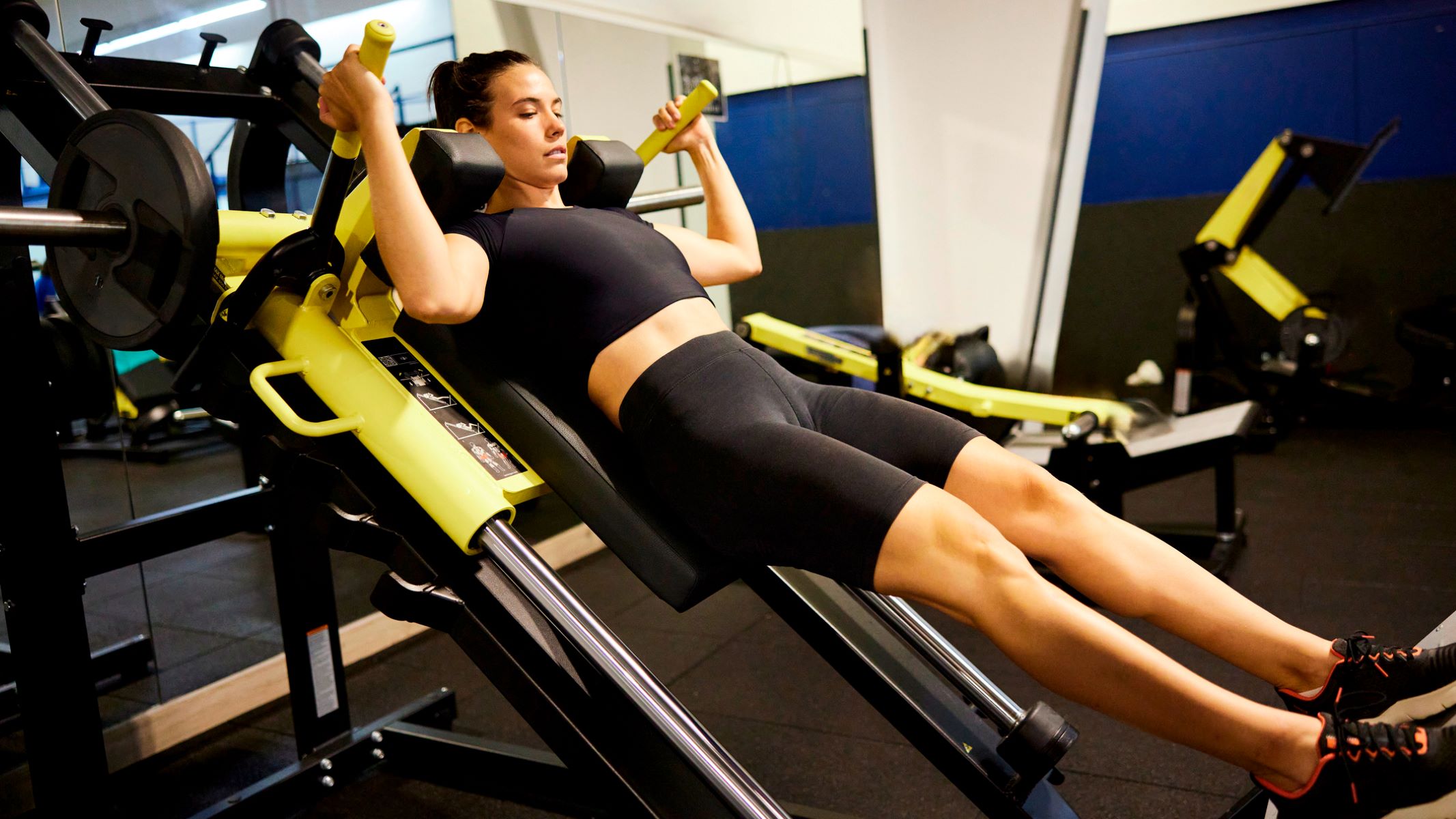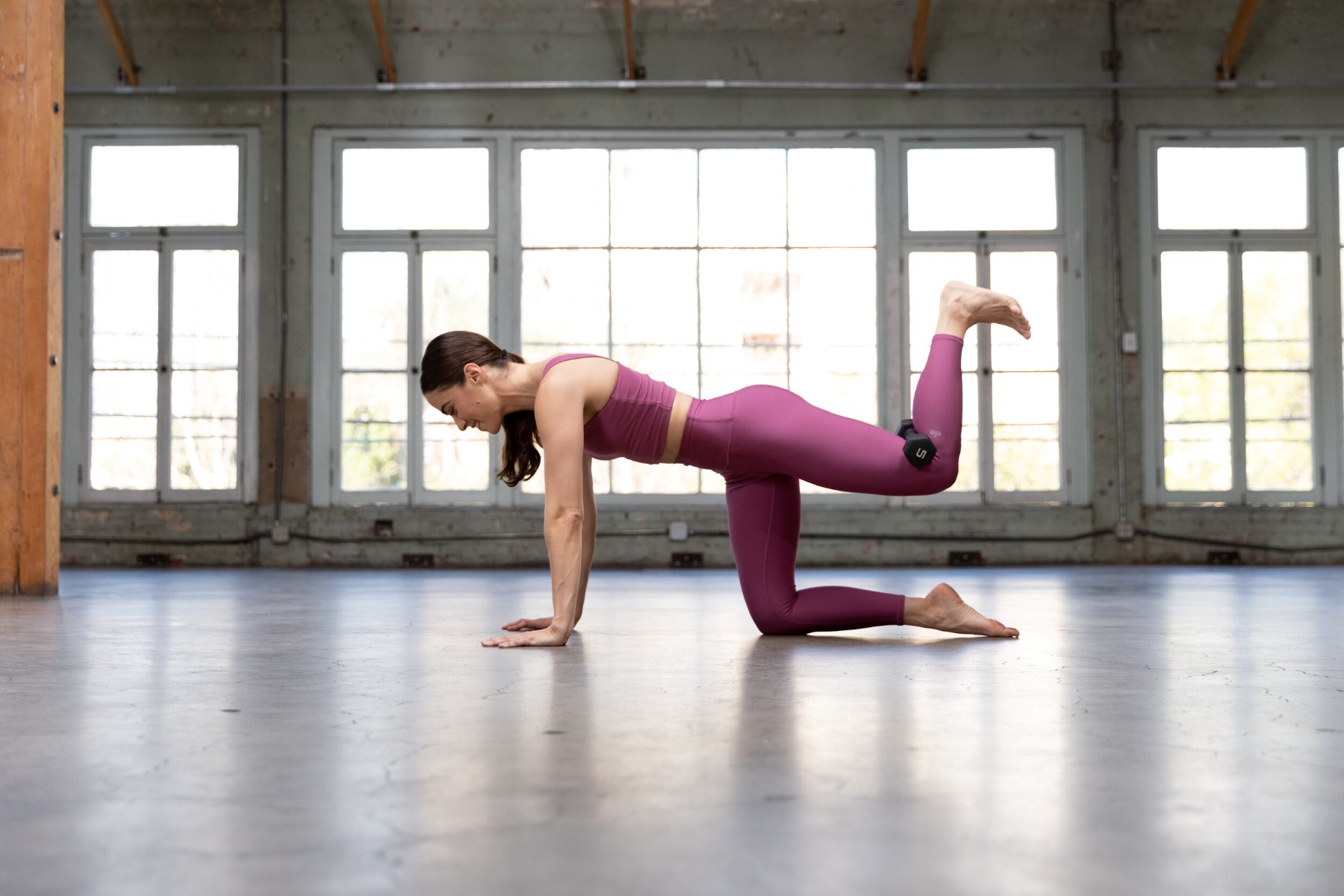Home>Health and Wellness>Achieve Perfect Balance With These Barbell Hack Squat Tips!


Health and Wellness
Achieve Perfect Balance With These Barbell Hack Squat Tips!
Published: February 7, 2024
Achieve perfect balance and strength with these barbell hack squat tips! Enhance your health and wellness with expert guidance on proper form and technique.
(Many of the links in this article redirect to a specific reviewed product. Your purchase of these products through affiliate links helps to generate commission for Regretless.com, at no extra cost. Learn more)
Table of Contents
Introduction
Welcome to the world of barbell hack squats, a dynamic and effective exercise that can help you achieve remarkable strength and muscle development. Whether you're a seasoned fitness enthusiast or just beginning your wellness journey, mastering the barbell hack squat can significantly enhance your lower body strength, stability, and overall physical performance.
Incorporating the barbell hack squat into your workout routine offers a multitude of benefits, including targeting key muscle groups such as the quadriceps, hamstrings, glutes, and calves. This compound movement also engages various stabilizing muscles, promoting balanced muscle development and functional strength.
By delving into the nuances of proper form, technique, and breathing strategies, you can optimize the benefits of barbell hack squats while minimizing the risk of injury. Understanding the common mistakes to avoid and the ideal range of motion will empower you to perform this exercise with confidence and precision.
Throughout this comprehensive guide, we'll explore the intricacies of foot placement, barbell positioning, and breathing techniques to ensure that you derive maximum value from your barbell hack squat routine. Additionally, we'll highlight the numerous advantages of incorporating this exercise into your fitness regimen, providing you with the motivation and knowledge needed to take your workouts to the next level.
Whether you're seeking to enhance your athletic performance, build muscle mass, or simply improve your overall fitness, the barbell hack squat is a versatile and impactful exercise that can help you achieve your goals. So, let's embark on this enlightening journey to master the art of barbell hack squats and unlock the full potential of your lower body strength and stability.
Proper Form and Technique
Executing the barbell hack squat with proper form and technique is crucial for maximizing its benefits and minimizing the risk of injury. Here's a detailed breakdown of the essential elements to consider when performing this exercise:
-
Starting Position: Begin by standing in front of a barbell with your feet shoulder-width apart. The barbell should be positioned behind your legs. Maintain a straight posture with your chest up and shoulders back to engage your core and stabilize your upper body.
-
Grip and Hand Placement: Reach behind you to grasp the barbell with an overhand grip, ensuring that your hands are slightly wider than shoulder-width apart. This grip provides stability and control throughout the movement.
-
Engage the Lower Body: Lower your body by bending at the knees and hips, ensuring that your back remains straight and your chest is lifted. Keep your head facing forward to maintain proper alignment.
-
Range of Motion: Descend until your thighs are parallel to the ground or slightly below, ensuring that your knees track in line with your toes. It's essential to maintain control and avoid bouncing at the bottom of the movement to prevent unnecessary strain on the knees and lower back.
-
Ascent and Extension: Push through your heels and engage your quadriceps, hamstrings, and glutes to ascend back to the starting position. Focus on a smooth and controlled movement, emphasizing the contraction of the targeted muscle groups.
-
Breathing Technique: Inhale as you lower your body and exhale as you push through the upward phase of the movement. Consistent and rhythmic breathing supports proper oxygen flow and enhances overall stability during the exercise.
-
Maintain Stability: Throughout the entire movement, maintain stability and control by keeping your core engaged and your body aligned. Avoid leaning forward excessively or allowing your knees to collapse inward, as this can lead to improper muscle engagement and potential strain.
By adhering to these fundamental principles of proper form and technique, you can effectively target the intended muscle groups while minimizing the risk of injury. Understanding the nuances of each phase of the movement and maintaining mindful awareness of your body's positioning are essential for reaping the full benefits of the barbell hack squat exercise.
Foot Placement and Stance
The positioning of your feet and the stance you adopt play a pivotal role in optimizing the effectiveness of the barbell hack squat. Proper foot placement and stance not only contribute to the targeted engagement of specific muscle groups but also ensure stability and balance throughout the exercise.
Foot Placement
When preparing for a barbell hack squat, your feet should be positioned at approximately shoulder-width apart. This placement provides a stable foundation and allows for optimal distribution of weight as you descend into the squat position. Additionally, maintaining a consistent foot placement from one repetition to the next promotes muscle memory and helps refine your overall technique.
Stance
The stance you adopt during the barbell hack squat can vary based on individual comfort and biomechanics. Some individuals may find that a slightly turned-out stance, where the toes are angled outward, enhances their ability to engage the quadriceps and glutes effectively. Others may prefer a more neutral stance, with the toes pointing forward, to distribute the workload evenly across the lower body muscles.
Furthermore, the angle of your feet in relation to your body can influence the degree of activation in the quadriceps and hamstrings. Experimenting with different foot angles and stances during your barbell hack squat routine can help you identify the positioning that optimally targets your desired muscle groups while maintaining comfort and stability.
By paying attention to foot placement and stance, you can customize your barbell hack squat technique to align with your unique biomechanics and fitness goals. Consistently evaluating and adjusting your foot positioning based on feedback from your body's response to the exercise enables you to refine your form and maximize the benefits of this dynamic lower body movement.
Incorporating variations in foot placement and stance can also add diversity to your workout routine, stimulating muscle adaptation and promoting well-rounded lower body development. Whether you opt for a traditional shoulder-width stance or experiment with different foot angles, maintaining mindful awareness of your feet's positioning is essential for harnessing the full potential of the barbell hack squat.
As you progress in your fitness journey, your understanding of how foot placement and stance influence your barbell hack squat performance will continue to evolve. Embrace the opportunity to explore and refine your technique, allowing your feet to serve as the foundational anchors that support and drive your lower body strength and stability during each repetition.
Barbell Positioning
The proper positioning of the barbell is a critical aspect of mastering the barbell hack squat, as it directly influences the distribution of weight, stability, and overall execution of the exercise. When preparing to perform the barbell hack squat, the placement of the barbell behind the legs is essential for maintaining balance and optimizing muscle engagement.
As you approach the barbell, ensure that it is positioned securely behind your legs, resting just below the calves. This placement allows for a natural and unhindered range of motion as you descend into the squat position. Grasping the barbell with an overhand grip, slightly wider than shoulder-width apart, provides stability and control throughout the movement. It's important to maintain a firm grip on the barbell to prevent slippage or instability during the exercise.
Additionally, the barbell's placement behind the legs encourages a more upright torso position, promoting proper alignment and reducing the risk of excessive forward lean. This upright posture not only minimizes stress on the lower back but also enhances the activation of the quadriceps, hamstrings, and glutes, which are the primary muscle groups targeted during the barbell hack squat.
The positioning of the barbell also influences the mechanics of the exercise, allowing for a smooth and controlled descent into the squat position without obstruction. By maintaining the barbell behind the legs, you can execute the movement with greater precision and stability, ensuring that the focus remains on engaging the lower body muscles effectively.
Furthermore, the placement of the barbell behind the legs encourages a deeper range of motion, enabling the quadriceps and hamstrings to be fully engaged throughout the exercise. This increased range of motion contributes to enhanced muscle activation and development, making the barbell hack squat a highly effective lower body strengthening exercise.
By understanding and implementing proper barbell positioning, you can optimize the execution of the barbell hack squat, promoting balanced muscle development, stability, and strength in the lower body. Consistently refining your awareness of the barbell's placement and its impact on your performance will empower you to derive maximum benefit from this dynamic and impactful exercise.
Range of Motion
The range of motion is a fundamental aspect of the barbell hack squat, dictating the depth of the squat and directly influencing the degree of muscle engagement and development. Achieving an optimal range of motion is essential for reaping the full benefits of this lower body exercise while minimizing the risk of potential strain or injury.
When performing the barbell hack squat, the ideal range of motion entails descending until your thighs are parallel to the ground or slightly below. This depth allows for maximal activation of the quadriceps, hamstrings, and glutes, promoting comprehensive lower body development. It's important to emphasize control and stability throughout the descent, avoiding any abrupt or uncontrolled movements that may compromise form or lead to unnecessary strain on the knees and lower back.
Maintaining a consistent and controlled range of motion enables the targeted muscle groups to be fully engaged, fostering strength and resilience in the lower body. By descending to the appropriate depth, you can effectively challenge the muscles while promoting functional strength and stability.
Furthermore, achieving a sufficient range of motion during the barbell hack squat supports enhanced flexibility and mobility in the lower body. The controlled descent and ascent through a full range of motion contribute to improved joint flexibility and muscular elasticity, which are vital components of overall physical well-being.
Incorporating a complete range of motion into your barbell hack squat routine also supports balanced muscle development and symmetry. By consistently engaging in deep, controlled squats, you can ensure that all targeted muscle groups are equally stimulated, reducing the likelihood of muscular imbalances and promoting overall aesthetic harmony.
It's important to note that while striving for an optimal range of motion, it's essential to prioritize quality over quantity. Emphasizing control, stability, and mindful muscle engagement throughout the entire range of motion is key to reaping the full benefits of the barbell hack squat.
By conscientiously honing your ability to execute the barbell hack squat with a complete and controlled range of motion, you can unlock the exercise's full potential, fostering lower body strength, stability, and mobility. Consistently refining your technique to encompass an ideal range of motion will empower you to derive maximum benefit from this dynamic and impactful lower body exercise.
Breathing Technique
The breathing technique employed during the barbell hack squat plays a pivotal role in enhancing performance, stability, and overall effectiveness of the exercise. By harmonizing your breath with the movement, you can optimize oxygen flow, maintain intra-abdominal pressure, and promote muscular engagement throughout the squatting motion.
As you initiate the descent into the squat position, inhale deeply and steadily. This inhalation pattern serves to expand the chest and diaphragm, facilitating optimal oxygen intake. The influx of oxygen nourishes the muscles, preparing them for the exertion required during the upward phase of the squat. Additionally, the act of inhaling deeply contributes to the stabilization of the core, promoting a strong and resilient foundation to support the movement.
Upon reaching the lowest point of the squat, where your thighs are parallel to the ground or slightly below, prepare to transition into the ascent phase. As you begin to push through your heels and engage the lower body muscles to rise back to the starting position, exhale forcefully and deliberately. This exhalation pattern aids in the activation of the deep core muscles, enhancing stability and promoting efficient energy transfer throughout the body.
Consistent and rhythmic breathing not only supports the physical demands of the barbell hack squat but also fosters mental focus and concentration. By synchronizing your breath with the movement, you can cultivate a sense of mindfulness and presence, allowing you to maintain control and intentionality throughout each repetition. This mindful approach to breathing can contribute to a heightened mind-muscle connection, enabling you to optimize muscle engagement and performance.
Moreover, the deliberate exhalation during the upward phase of the squat serves to expel carbon dioxide and metabolic by-products, facilitating efficient oxygen utilization and enhancing overall endurance. By effectively managing your breath, you can sustain energy levels and prolong your capacity to perform the exercise with precision and vigor.
Incorporating a conscious and deliberate breathing technique into your barbell hack squat routine allows you to harness the power of breath as a supportive and integral component of the exercise. By prioritizing controlled inhalation and exhalation, you can elevate the quality of your movement, promote stability and endurance, and optimize the overall efficacy of the barbell hack squat.
As you continue to refine your breathing technique in tandem with the barbell hack squat, you'll cultivate a profound understanding of the synergistic relationship between breath and movement, empowering you to achieve greater physical prowess and mastery of this dynamic lower body exercise.
Common Mistakes to Avoid
Mastering the barbell hack squat requires not only a firm grasp of proper form and technique but also a keen awareness of common mistakes that can compromise the effectiveness and safety of the exercise. By recognizing and addressing these pitfalls, you can elevate your performance and mitigate the risk of potential injury, ensuring that each repetition contributes to your lower body strength and stability.
-
Excessive Forward Lean: One prevalent mistake is leaning excessively forward during the descent into the squat position. This forward lean places undue stress on the lower back and diminishes the engagement of the targeted lower body muscles. To avoid this, focus on maintaining an upright torso and distributing the weight evenly through the feet, allowing for optimal muscle activation.
-
Inadequate Range of Motion: Failing to achieve a sufficient depth in the squat is another common error. Restricting the range of motion limits the engagement of the quadriceps, hamstrings, and glutes, detracting from the exercise's effectiveness. Strive to descend until the thighs are parallel to the ground or slightly below, ensuring comprehensive muscle activation and development.
-
Improper Foot Placement: Incorrect foot positioning, such as excessively wide or narrow stances, can compromise stability and impede the fluidity of the movement. It's essential to maintain a shoulder-width stance and align the feet parallel to ensure optimal weight distribution and muscle engagement.
-
Lack of Core Engagement: Neglecting to engage the core muscles throughout the exercise diminishes stability and increases the risk of injury. Maintaining a strong and activated core supports proper posture and alignment, facilitating the effective execution of the barbell hack squat.
-
Rapid or Bouncing Movements: Engaging in rapid, uncontrolled movements or bouncing at the bottom of the squat can lead to unnecessary strain on the knees and lower back. Emphasize a controlled descent and ascent, avoiding any abrupt or jerky motions that compromise form and safety.
-
Inconsistent Breathing: Disregarding the importance of rhythmic breathing can hinder overall stability and endurance during the exercise. Consistent inhalation and exhalation patterns support optimal oxygen flow and core engagement, contributing to enhanced performance and mindfulness.
By conscientiously avoiding these common mistakes and prioritizing mindful, controlled execution, you can elevate the quality of your barbell hack squat routine. Cultivating an acute awareness of these pitfalls empowers you to refine your technique, minimize the risk of injury, and unlock the full potential of this dynamic lower body exercise.
Read more: How To Clean New Balance Shoes
Benefits of Barbell Hack Squats
The barbell hack squat is a versatile and impactful exercise that offers a myriad of benefits, making it a valuable addition to any lower body workout routine. By incorporating this dynamic movement into your fitness regimen, you can experience a comprehensive range of advantages that contribute to enhanced strength, muscle development, and overall physical well-being.
Targeted Muscle Engagement
One of the primary benefits of barbell hack squats is the targeted engagement of key lower body muscle groups. This compound exercise effectively activates the quadriceps, hamstrings, glutes, and calves, promoting balanced muscle development and functional strength. The controlled descent and ascent through a full range of motion ensure that these muscle groups are thoroughly stimulated, contributing to improved lower body endurance and resilience.
Increased Lower Body Strength
Performing barbell hack squats on a regular basis can lead to significant gains in lower body strength. By challenging the muscles through a demanding range of motion and resistance, this exercise fosters muscular adaptation and growth. The enhanced strength in the quadriceps, hamstrings, and glutes translates to improved performance in various functional movements and athletic activities, empowering individuals to move with greater power and stability.
Improved Stability and Balance
The barbell hack squat places a strong emphasis on core stability and overall balance, as the body is required to maintain proper alignment and control throughout the movement. This focus on stability not only strengthens the core muscles but also enhances proprioception and coordination, contributing to better overall balance and postural control.
Read more: How To Achieve The Perfect Butterfly Haircut
Joint Flexibility and Mobility
Engaging in barbell hack squats supports improved joint flexibility and mobility in the lower body. The controlled descent into the squat position encourages the hips, knees, and ankles to move through a full range of motion, promoting joint health and preventing stiffness. Enhanced flexibility and mobility in these key joints contribute to better functional movement patterns and reduced risk of injury during physical activities.
Versatility and Adaptability
Another notable benefit of barbell hack squats is their versatility and adaptability to different fitness levels and goals. Whether you're a novice seeking to build foundational strength or an experienced athlete aiming to enhance lower body power, the barbell hack squat can be modified to accommodate varying resistance levels and movement patterns. This adaptability makes it a valuable exercise for individuals at all stages of their fitness journey.
Enhanced Aesthetic Development
In addition to the functional benefits, barbell hack squats contribute to enhanced aesthetic development of the lower body. The targeted engagement of the quadriceps, hamstrings, and glutes results in improved muscle definition and tone. As these muscle groups become stronger and more developed, individuals may experience a more sculpted and athletic appearance in their lower body, further motivating and rewarding their fitness efforts.
Mental Focus and Mind-Muscle Connection
Performing barbell hack squats requires a high degree of mental focus and mind-muscle connection. By concentrating on proper form, breathing, and muscle engagement throughout each repetition, individuals can cultivate a heightened awareness of their body and movement patterns. This mindful approach not only enhances the quality of the exercise but also promotes mental clarity and concentration during workouts.
Incorporating barbell hack squats into your fitness routine can yield a wealth of benefits that extend beyond the physical realm. From targeted muscle engagement and increased strength to improved stability, flexibility, and mental focus, this exercise offers a holistic approach to lower body development and overall well-being. By embracing the diverse advantages of barbell hack squats, individuals can elevate their fitness journey and experience profound enhancements in their lower body strength, stability, and physical performance.
Conclusion
In conclusion, the barbell hack squat stands as a formidable exercise that encompasses a myriad of benefits, ranging from targeted muscle engagement and increased lower body strength to enhanced stability, joint flexibility, and mental focus. By delving into the intricacies of proper form, foot placement, barbell positioning, range of motion, breathing technique, and common mistakes to avoid, individuals can elevate their performance and maximize the efficacy of this dynamic lower body movement.
The comprehensive engagement of key muscle groups, including the quadriceps, hamstrings, glutes, and calves, positions the barbell hack squat as a cornerstone exercise for promoting balanced muscle development and functional strength. The deliberate focus on core stability and overall balance fosters not only physical resilience but also heightened proprioception and coordination, contributing to better overall balance and postural control.
Furthermore, the emphasis on joint flexibility and mobility underscores the holistic benefits of the barbell hack squat, promoting joint health and preventing stiffness. The exercise's adaptability and versatility make it accessible to individuals at varying fitness levels, enabling them to tailor the movement to their unique goals and capabilities.
Beyond the physical advantages, the barbell hack squat cultivates a profound mind-muscle connection, fostering mental clarity, concentration, and mindfulness during workouts. This holistic approach to lower body development transcends mere physical gains, offering individuals a comprehensive pathway to unlocking their full potential in strength, stability, and overall well-being.
As individuals continue to integrate the barbell hack squat into their fitness regimens, they can expect to experience a transformative journey marked by enhanced lower body strength, improved stability, and a heightened sense of physical and mental awareness. By embracing the diverse advantages of this exercise, individuals can embark on a fulfilling and empowering pursuit of holistic wellness and physical mastery.
In essence, the barbell hack squat represents more than a mere exercise; it symbolizes a gateway to comprehensive lower body development, resilience, and unwavering determination. It stands as a testament to the remarkable capabilities of the human body and the profound impact that intentional, mindful movement can have on one's physical and mental well-being.











